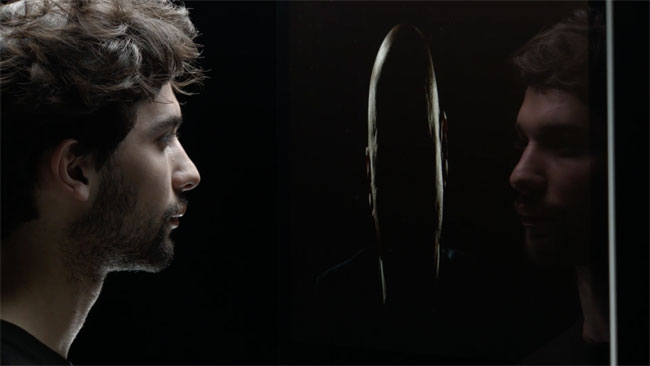— Eating Glass: The New Propaganda

Imagine a Louis Vuitton pattern. Now imagine the shapes of the pattern, each of them, slowly curling into question marks. Imagine that pattern being printed across reality. Everything occurring in spacetime becomes a luxury handbag of question marks. There wasn’t enough of a budget to visualize this in After Effects, so you’ll have to use your imagination.
The philosopher Jacques Ellul once wrote that “nothing is worse in times of danger than to live in a dream world.” But he added that “propaganda is a good deal less the political weapon of a regime ... than the effect of a technological society that embraces the entire man.” Propaganda overlays reality with an interface that dominates and kills what it was supposed to mediate.

The emergence of a global communications grid in which we are all broadcasting mirrors the decline of an order in which we might agree on what to say. At least for a brief part of modern history, geopolitics were organized around systems of multilateral collaboration. These systems tried to work with the many realities that feed into complex problems. But this approach is disintegrating.
As the billionaire philanthropist George Soros asserts in The New York Review of Books, “international cooperation is in decline both in the political and financial spheres.” Pankaj Mishra writes in the Guardian that a “world organized for the play of individual self-interest looks more and more prone to manic tribalism.” Pope Francis is currently fighting climate change more compellingly than any international organization in recent history. That’s also a sign of the deterioration of an international order that ought to take action but can’t anymore. The return of the quasi-medieval agency of the papacy (granted, for a progressive cause) casts light on a creeping feudalism to which we concede to ourselves more and more openly, saying that “this is the way the world works.”
The post-1945 European ideal of interstate compromise has declined into stale protocol, algorithmic governance, robotic decision making, and technocratic dead stares. An attempt to dramatically reduce the unpredictability of politics has resulted in near-complete standardization, giving way to the technocrat as the posthuman Ghost Rider of permanent austerity.1In multilateral technocracy, the unelected finance expert has emerged as an ideal-type politician, binding each and every part of the system—including fiscal and monetary governance—to strictly-obeyed standards and rules. Technocratic governance, as a political model, can only with great difficulty hold out against the Schmittian lure of the friend-enemy construction exploited by the right-wing populists. Worse, it can, as the Greece-Germany example demonstrates, itself become the vehicle of such a dynamic: financial rules and regulations are then used to “mentally waterboard” (the Guardian) the disobedient country, crossing a line from conditions to sanctions. For all its obsession with protocol, technocratic governance can’t offer its members a spiritual and ideological unity which binds them to unwritten rules of mutual ethics, care, and loyalty. In the end, technocracy is a dream world without anything to dream of. This is the approach by which the European project has been brought to its knees. Not by Russia or ISIS, but by the EU’s own financial clerks and clerics.
The recent and ongoing drama around Greece, Germany, and Europe is a good example of the state of propaganda today. In this drama there are multiple narratives that lay claim to the same events, places, and people. The narratives do not share the same explanations; they could well be conceived on different planets. But they lay claim to the same things, like “filter bubbles,” inside of which everything is a coherent narrative—just please don’t leave the bubble.2Yanis Varoufakis, Greece’s former finance minister, reported of his confrontations with the Eurogroup that was handling the Greek loans. When Varoufakis tried to present his and Greece’s ideas about austerity and debt restructuring, he was “faced with blank stares. It is as if you haven’t spoken. What you say is independent of what they say. You might as well have sung the Swedish national anthem.”
In the saga, Germany did everything right; its “moralizing sermons” and “obsession with rules” (The Economist) amount to a universe where everything can be explained according to regulations that only Germany can live up to. This logic may have devastating consequences when followed to its ends, where it is imposed to discipline and punish disobedient fellow eurozone members. Such was the Draconian surrender package demanded of Greece on the eve of July 12, 2015, which amounted to a declaration of financial war by Europe’s most powerful economy—in Merkel’s words, to restore “the most important currency: trust.”
Months earlier, German satiricists seamlessly after-effected and post-produced Greek finance minister Yanis Varoufakis giving the finger to Germany in a video that had been originally broadcast on the country’s public television channel. Explained as satire, this hoax was allegedly intended as a liberal provocation of right-wing Bild columnists, yet it was also remarkably suited to Germany’s own ideological Oculus Rift. Superior control of digital tools could present an “as such” technological, even “technocratic,” augmented reality to Varoufakis and Greece, in which the Germans assumed total control over the Greek image: a colonial gesture of software superiority, by wealthy hipsters, at the expense of a struggling edge of the eurozone. Also, the middle finger would excuse the audience to forget Varoufakis’ arguments about the EU’s austerity policies. After the manipulated video went viral, Varoufakis had to publicly deny he did it. He was forced to say “It’s fake.” And it was.

A case in point in the overthrowing of the multilateral order was the 2003 US- and UK-led invasion of Iraq. The campaign was legitimized with fabricated evidence of Saddam Hussein’s non-existent weapons of mass destruction.3A set of counterfeit documents, purportedly belonging to the government of Niger, were key. These documents, which suggested that Saddam Hussein was buying uranium in the African country, were faked so badly that CNN said about them that they could not have been produced by a Western intelligence agency. Presented to the United Nations as a no-brainer, the invasion abused and ravaged the very idea of “cooperation.” The future leadership of ISIS was forged in a US prison in Iraq, where jihadist insurgents and former Iraqi Baath Party officials were detained together. A White House aide told a journalist that “we’re an empire now, and when we act, we create our own reality. And while you are studying that reality we’ll act again, creating other new realities, which you can study, too.”
If ever more entities in the geopolitical realm refuse to take off their augmented reality mediashades, how do their dream worlds get inscribed into other people’s realities, physical spaces, and political geographies? The political theorist James Der Derian hinted at such questions when he predicted the emergence of “temporal, perceptual wars,” exploring “not just the traditional boundaries of international relations but also the inadequately mapped boundaries between self and other, inside and outside, war and peace.”
The internet began to fill in for the multilateral world order. Information technology was seen as a distributor of freedom, and its programming language was written by the West. It wasn’t about negotiating with authoritarian countries anymore, but about the spontaneous conversion of their populations into liberals. For example, in 2009 the US State Department asked the microblogging platform Twitter to postpone its scheduled maintenance, so that Iranian political protests could keep relying on the service.4Concurrently the US and Israel created an advanced digital weapon against Iran that did the exact opposite of “civil society activism.” Stuxnet traversed the web from a set of spoof football domains, delivering its lethal piece of code to the computers controlling Iran’s Natanz nuclear reactor (which was, thankfully, protected by anti-aircraft guns). The last leg of Stuxnet’s journey from the web to the reactor’s control panel was by USB key. A 2010 speech by US Secretary of State Hillary Clinton became the official false start of the internet’s takeover of internationalism. Stone-faced, Clinton professed that censors around the world were furiously erasing her words from the historical record.
The political changes aided by information technology were assumed to fall well within the scope of internationalism. Revolutions were named after (usually vivid) colors, or after Facebook and Twitter. With McLuhanian automation, the communication tools used during uprisings were regarded not merely as the medium but also as the message of these events. The technology was mistaken for political content.5Planetary-scale computation does not discriminate according to intent or content. Its usage does not reveal anything of the like. This lack of discrimination is emphasized in digital tools like Dark Wallet, an anonymized and encrypted “wallet” for the Bitcoin crypto-currency. Dark Wallet takes encryption and privacy as the default zero-point of online and offline existence. Inventions like Dark Wallet, and the even more ambitious system Ethereum, draw on a rigorously objectivized idea of technology as embodied in the block chain, a transaction registry central to Bitcoin which eliminates intermediaries like banks. This disrupts further claims of nation-states, or geopolitics, on the ultimate objective or aim of technology. Dark Wallet’s Amir Taaki defended this principle convincingly, after Dark Wallet became flagged in an ISIS-related blog as a potential instrument for the terrorist caliphate to hide its finances. Taaki explained that, though he didn’t like ISIS, the technology is for everyone.
As the Egyptian journalist Lina Attalah explains,
In the rare instance where content is addressed, it is to mark your political identity. So you find maps showing how many Islamists, versus how many liberals, versus how many leftists are in a given country. We also make fun about how we have been turned into dots on these maps and how there is no interest in understanding more deeply what these dots are, because that’s not the work of techies but probably that of the humanities, which are not as integrated in the study of the internet as they should be.6Lina Attalah, email to the authors, March 8, 2015.
In 2005, the German synth-pop band Propaganda reformed. In the same year, the Kremlin-owned news channel RT started broadcasting. YouTube, the world’s largest online video platform, was founded in 2005. It was purchased by Google a year later.
By 2005 Russia’s frozen conflicts around former Soviet states had already created semi-permanent geopolitical black holes. Places like Transdnistria, Abkhazia, and South Ossetia prowled into the world map. Expulsions of delinquent oligarchs and power plays with fossil energy were in progress. In an address to the Russian Federal Assembly, Vladimir Putin called Russia a “major European power.” More recently, the idea has emerged that Russia should be considered a superpower. The 2014 annexation of Crimea and the pro-Russian uprising and civil war in eastern Ukraine are seen as litmus tests for the new order that Putin wants.
Western scrutiny of this order involves a narrow band of key words, repeated at each verdict. Terms like “corruption,” “mafia,” and “psychological warfare” may be useful catch-all epithets to describe Putin’s regime, but their frequent usage can also prove to be counterproductive. For example, the RT news channel, formerly called Russia Today, has started to pride itself on being labeled a propaganda machine, intent to shatter what it considers to be illusory beliefs about objective, fact-based news media. But how did RT get there? Its self-explanation hinges on the 2003 Iraq invasion, when Western politicians who lied to the public were endorsed by a fawning press corps. This calls for a Russian-controlled mainstream medium that can act as an adversary to Western power, incessantly challenging its every move. Putin’s “ownership” of the narrative is confirmed by RT host Peter Lavelle, who calls the Russian president “the face of global resistance against Western hegemony.”7See “Putin answering Peter Lavelle,” RT excerpt.
The crucial element of this story is that propaganda has transformed from a repetitive, monotonous drone of easily discernible falsehoods into a theater of endless questioning. Chameleonic criticality, skillful provocation, and incessant subversion have taken the place of the singular narrative of the despotic OneState.8The OneState is a fictional sovereign entity in Evgeny Zamyatin’s 1928 science-fiction novel, We. It is an all-knowing authoritarian government led by an all-seeing “Benefactor.” Dmitry Kiselyov, a Russian spin-doctor and state television boss, proposed that “objectivity does not exist.” He told the RIA Novosti news agency that “there’s not one publication in the world that’s objective. Is CNN objective? No. Is the BBC objective? No. Objectivity is a myth, which they propose to us and impose on us.”

Timothy Snyder, a history professor at Yale, compares the Russian strategy to “applied postmodernism.” Events are unpredictable and unstructured, and can be considered in various ways. But there is no way they can be fully accounted for by a single interpretation. Postmodernism becomes pragmatism in the concept of maskirovka or “masking”—plausible deniability, something essential for Moscow’s hidden-yet-obvious involvement in the conflict in Ukraine.
Propaganda is an art that undermines through a process of endless seeking. It is an extreme sport, like bungee jumping off the high-rises of reality itself, and pursued for its own sake. The quest isn’t linked to a wish for clarity. On the contrary, it aspires to a spiritual admission of the human condition. People with power first act as gods, hiding some facts and exaggerating others. Then they retreat to their mere humanity and claim that no one can know.
In Andrei Tarkovsky’s 1980 psycho-philosophical science-fiction drama Stalker, the character known as the “Writer,” after arrival in the “Room” at the heart of the sentient, post-apocalyptic “Zone,” concedes that “There’s no such thing as facts, especially here.” In a scene that was eventually dropped from Tarkovsky’s 1983 Nostalgia, the protagonist tells two Italian women a story over lunch about Russians eating glass, to prove their “ability to do anything and everything.” There’s a similar plot at work in the new propaganda. Instead of in the literary and cinematic imagination, it is playing out in a war. The Russian soul was hijacked by a Schmittian endgame.
In an obscure Russian video available on YouTube, two middle-aged men sit at an office table discussing the state of play in Ukraine. They agree that Putin has taken a cowardly turn from the great war he ought to have launched there. He should have pushed for Novorossiya, a pixelated retro-accelerationist motherland with its own YouTube channel, comprised of the Luhansk and Donetsk oblasts in eastern Ukraine. But he didn’t. The men concur that Ukrainian citizens are being exposed to a brainwashing experiment by the state television, and as a result are turning into zombies. One of the men admits that while watching Ukrainian television he began to exhibit signs of zombification, involving such feelings as regret and sorrow. He then switched off the television set and felt much better.
That man is Igor “Strelkov” Girkin, former commander-in-chief of the armed forces of the Donetsk People’s Republic, an unrecognized territorial entity that formed as part of the pro-Russian uprising in Ukraine’s industrial east. Strelkov, who has been photographed in medieval battle attire and whose hairstyle resembles that of a nineteenth century cavalry officer, was already involved in setting up Transdnistria, a semi-official mini-state in Moldova that is covered in Soviet insignia. Strelkov was quietly removed from Donetsk command after a Malaysian Airlines commercial airliner was downed by a missile over eastern Ukraine last July, killing all 298 passengers and crew.
In a letter to Slavoj Žižek, Pussy Riot member Nadya Tolokonnikova, writing while incarcerated in a labor camp in Mordovia, cites the Russian political and religious philosopher Nikolai Berdyaev:
Truth as an object which intrudes itself and wields authority over me—an object in the name of which it is demanded that I should renounce freedom—is a figment: truth is no extraneous thing; it is the way and the life. Truth is spiritual conquest; it is known in and through freedom.9Nadeshda Tolokonnikova, Comradely Greetings: The Prison Letters of Nadya and Slavoj, (London: Verso, 2014), 40.
In his Truth and Revelation, Berdyaev wrote that “truth is not something given objectively, but rather a creative achievement. It is creative discovery, rather than the reflected knowledge of an object or of being. Truth ... is the creative transfiguration of reality.”10Nikolai Berdyaev, Truth and Revelation: Prolegomena to the Critique of Revelation (Istina i otkrovenie. Prolegomeny k kritike otkroveniya), trans. R. M. French (New York: Harper and Bros., 1953), 14.
In applied postmodernism, this psycho-philosophical quest comes to be appropriated as a geopolitical technique at a particularly perilous and seductive intersection of politics and aesthetics. Geopolitics, once determined, but perhaps never predictably, by a “rulebook” written by the division of planetary surface into nation-states, seems now torn by a not-unprecedented, but never so intensely experienced, steadily escalating regime in which the image is the fight and the image is also art.

Russia invaded the Crimean peninsula and annexed it from Ukraine in early 2014. While RT had so far directed its attention to events in the United States, it now had to turn its gaze to Russia. A sprawl of stories about the ensuing conflict was mixed with explosive viral videos such as Enjoykin’s Nyash Myash, a massive YouTube hit featuring the Russia-appointed Crimea prosecutor general Natalya Poklonskaya rendered in Japanese manga. Nyash Myash is built around an agonizing turbo pop track of the type that in post-Soviet Russia could be heard in shopping malls, swimming pools, and even parks. Shot through with bullet holes and splattering blood, the video always returns to the same fragment where Natalya smiles and says a teeny-weeny diminutive of her name: “Nyash Myash.” RT reported that the prosecutor had become an internet sensation in Japan. Natalya’s attire transformed into a boarding school uniform; her eyes grew to saucers while her chin and mouth shrank to those of a young child. She wielded her sword at monsters.
×
This text by Daniel van der Velden and Vinca Kruk was excerpted from Metahaven’s forthcoming (2015) moving image project The Sprawl, co-produced with Lighthouse, and commissioned by Lighthouse and The Space. Interviews with Monalisa Gharavi, Benjamin H. Bratton, and Peter Pomerantsev, all featuring in The Sprawl, have added to the arguments presented here. Metahaven gave a three-day seminar at the European Graduate School (EGS) in 2015, where some of the sources for this text were read and discussed in depth. Anastasia Kubrak contributed research to this text. All images courtesy of the artists and part of the work Metahaven, The Sprawl, 2015. The Sprawl is co-produced by Lighthouse and commissioned by Lighthouse and The Space.


